 Well, as detailed on today's BradCast, we've been trying, for a long time to get answers about the new, unverifiable touchscreen voting systems set to replace Los Angeles County's verifiable hand-marked paper ballot system for the first time in the 2020 Presidential elections. Disappointingly, however, the L.A. County Clerk/Registrar-Recorder Dean Logan, who had been very responsive and helpful in previous years, no longer answers simple questions about the new voting system called "Voting Solutions for All People" (VSAP), which he has been developing for more than a decade. That is very troubling, as we explain in detail today. [Audio link to full show is posted below.]
Well, as detailed on today's BradCast, we've been trying, for a long time to get answers about the new, unverifiable touchscreen voting systems set to replace Los Angeles County's verifiable hand-marked paper ballot system for the first time in the 2020 Presidential elections. Disappointingly, however, the L.A. County Clerk/Registrar-Recorder Dean Logan, who had been very responsive and helpful in previous years, no longer answers simple questions about the new voting system called "Voting Solutions for All People" (VSAP), which he has been developing for more than a decade. That is very troubling, as we explain in detail today. [Audio link to full show is posted below.]
The new VSAP system is a touchscreen Ballot Marking Device or BMD, which prints out a computer-marked paper ballot summary of votes selected via the touchscreen, before using another computer, an optical-scanner, to read the non-human readable QR Code that is also printed on the ballot summary. The QR Codes are used to tally votes. While the QR Code (a type of barcode) cannot be verified for accuracy by voters, it is also impossible with such systems to know if any voter has even verified the human-readable portion of the ballot summary at all, much less correctly, after an election. Studies reveal that most do not verify computer-marked ballots at all, and that of the minority who do, most don't recall the details or selections on the ballot they voted just moments earlier. That's just one of the many reasons why most cybersecurity and voting systems experts warn against the use of such systems which are now proliferating --- and sometimes replacing verifiable hand-marked paper ballot systems --- in many states and counties across the country before 2020. (The list of states where counties or the entire state are moving to BMD systems include a number of key battleground states. Such systems are planned for use next year, or are already being used, in OH, WI, PA, TX, WV, KY, NY, NJ, KS, TN, IN, SC, NC and, yes, CA, unless the public prevents these plans.)
We have been trying to get simple answers from Logan about the VSAP project before voters are forced to use it next year in the nation's largest voting jurisdiction, but Logan has both repeatedly refused to answer many such questions and has declined repeated invitations to appear on the program, including today's. That, after he has joined us on a number of occasions over the years (the last time he joined us was in April 2013 to announce that the new system would be an unverifiable touchscreen system) and he used to be quite responsive to voter questions and concerns on Twitter and elsewhere.
Among the simple questions Logan refuses to answer of late:
- Will voters at the polls in Los Angeles still be allowed to vote on hand-marked paper ballots as previously mandated by the CA Sec. of State? (The office of Democratic SoS Alex Padilla, a supporter of the new system in L.A., has also not yet responded to that question.);
- Will there be paper backups of the new electronic pollbook systems used with VSAP at the new Voting Centers which will be replacing community precincts this year? (1,000 such Voting Centers will allow voters to vote from any of them, versus the 4,000 local precincts L.A. voters have used in the past);
- Will independent cybersecurity and voting systems experts like Harri Hursti, who has hacked many voting machines over the past decade or more, be allowed to carry out security and penetration tests on the system before it's used in the 2020 Presidential election? (Hursti has agreed to do so, but Logan has not responded, at least publicly, to take him up on his generous offer);
- Where is the public documentation for whatever certification and security testing that Logan claims to have already carried out?
- Why was a private, foreign-based voting systems vendor named Smartmatic given the nearly $300 million contract to build and program the systems, despite their disturbing record of mysterious foreign ownership and failed past elections?;
- Why does Los Angeles and the California Sec. of State characterize the new VSAP system as "open source", while refusing to disclose the so-called "open source" to the public and responding to public records request to review it (even from other elections officials!) by claiming the system's code is "propriety information", "trade secrets" and that disclosure would "reveal vulnerabilities to attack or would otherwise increase the potential for an attack on the public agency's information technology system"?
We would have preferred Logan joined us on air today to answer such questions, and many more from callers. However, as he declined, we were forced to do our best to answer them ourselves.
Moreover, it would also be helpful if corporate media bothered to cover any of these important issues to the public. The Los Angeles Times ran two stories on VSAP last week, one a fawning 1,900 feature article on Logan and his years-long development process for the system. Neither story by the Times' Matt Stiles --- including the one headlined "Ready for the voting overhaul in L.A. County? Here’s what you need to know" --- mentioned anything about the many security and verifiability concerns of the new system. Following my public complaints to that end over the past week, Stiles has told me he is considering a story on those concerns. I hope so! Voters need to corporate to step up to this stuff, even a tenth as much as they cover the horse race --- while ignoring the track conditions on which the horses will be running!
Arguably, as bad or worse, Washington Post has a page up on their website headlined "How Ballot-Marking Devices Work". There is no story or text on the WaPo page, remarkably enough, just an embedded version of a two-and-a-half minute promotional video for the VSAP project created by the L.A. County Registrar-Recorder/County Clerk's office. Seriously! Nonetheless, out of an abundance of fairness, we aired the full promotional video for the system on the program.
We take a deep (and often harrowing) dive into all of the above and much more --- along with listener calls, many of them furious, as they hear about this for the first time --- on today's BradCast...
(Snail mail support to "Brad Friedman, 7095 Hollywood Blvd., #594 Los Angeles, CA 90028" always welcome too!)
|


 Sunday 'Now Hoarding' Toons
Sunday 'Now Hoarding' Toons Mad World:
Mad World: 'Green News Report' 5/15/25
'Green News Report' 5/15/25
 Plane Corruption and the Future of the DOJ: 'BradCast' 5/14/25
Plane Corruption and the Future of the DOJ: 'BradCast' 5/14/25 'Deeply Evil': GOP Proposes Largest Medicaid Cuts in History: 'BradCast' 5/13/25
'Deeply Evil': GOP Proposes Largest Medicaid Cuts in History: 'BradCast' 5/13/25 'Green News Report' 5/13/25
'Green News Report' 5/13/25 And Then They Came for the Mayors...: 'BradCast' 5/12/25
And Then They Came for the Mayors...: 'BradCast' 5/12/25 Sunday 'New Guy, Old Guy' Toons
Sunday 'New Guy, Old Guy' Toons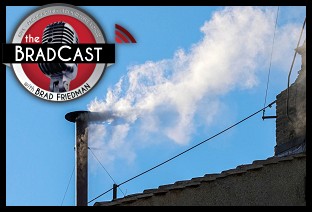 Blowing Smoke. At the Vatican and White House: 'BradCast' 5/8/25
Blowing Smoke. At the Vatican and White House: 'BradCast' 5/8/25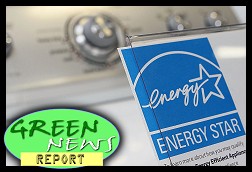 'Green News Report' 5/8/25
'Green News Report' 5/8/25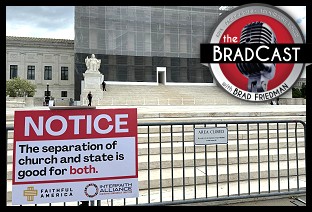 SCOTUS Weighs Public Funding of Religious Schools: 'BradCast' 5/7/25
SCOTUS Weighs Public Funding of Religious Schools: 'BradCast' 5/7/25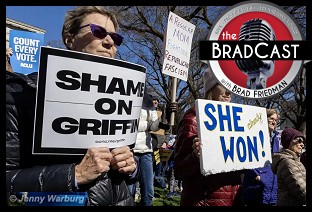 Trump Judge Blocks NC GOP Theft of 2024 Supreme Court Seat: 'BradCast' 5/6/25
Trump Judge Blocks NC GOP Theft of 2024 Supreme Court Seat: 'BradCast' 5/6/25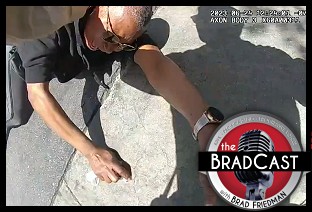 Prosecutors Quit After U.S Attny Strikes Deal With Felon Cop: 'BradCast' 5/5/25
Prosecutors Quit After U.S Attny Strikes Deal With Felon Cop: 'BradCast' 5/5/25 Trump Losing Streak Continues into SECOND Hundred Days: 'BradCast' 5/1/25
Trump Losing Streak Continues into SECOND Hundred Days: 'BradCast' 5/1/25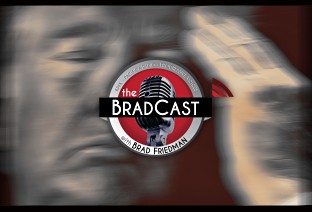 100 Daze (w/ Digby and Driftglass): 'BradCast' 4/30/25
100 Daze (w/ Digby and Driftglass): 'BradCast' 4/30/25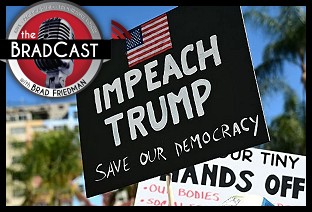 Campaign to 'Impeach Trump Again' Gains Fresh Momentum: 'BradCast' 4/29/25
Campaign to 'Impeach Trump Again' Gains Fresh Momentum: 'BradCast' 4/29/25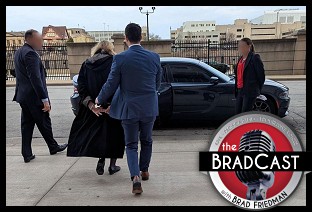 And Then They Came for the Judges...: 'BradCast' 4/28/25
And Then They Came for the Judges...: 'BradCast' 4/28/25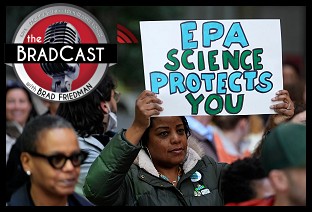 Trump EPA Guts Enviro Justice Office: 'BradCast' 4/24/25
Trump EPA Guts Enviro Justice Office: 'BradCast' 4/24/25
 VA GOP VOTER REG FRAUDSTER OFF HOOK
VA GOP VOTER REG FRAUDSTER OFF HOOK Criminal GOP Voter Registration Fraud Probe Expanding in VA
Criminal GOP Voter Registration Fraud Probe Expanding in VA DOJ PROBE SOUGHT AFTER VA ARREST
DOJ PROBE SOUGHT AFTER VA ARREST Arrest in VA: GOP Voter Reg Scandal Widens
Arrest in VA: GOP Voter Reg Scandal Widens ALL TOGETHER: ROVE, SPROUL, KOCHS, RNC
ALL TOGETHER: ROVE, SPROUL, KOCHS, RNC LATimes: RNC's 'Fired' Sproul Working for Repubs in 'as Many as 30 States'
LATimes: RNC's 'Fired' Sproul Working for Repubs in 'as Many as 30 States' 'Fired' Sproul Group 'Cloned', Still Working for Republicans in At Least 10 States
'Fired' Sproul Group 'Cloned', Still Working for Republicans in At Least 10 States FINALLY: FOX ON GOP REG FRAUD SCANDAL
FINALLY: FOX ON GOP REG FRAUD SCANDAL COLORADO FOLLOWS FLORIDA WITH GOP CRIMINAL INVESTIGATION
COLORADO FOLLOWS FLORIDA WITH GOP CRIMINAL INVESTIGATION CRIMINAL PROBE LAUNCHED INTO GOP VOTER REGISTRATION FRAUD SCANDAL IN FL
CRIMINAL PROBE LAUNCHED INTO GOP VOTER REGISTRATION FRAUD SCANDAL IN FL Brad Breaks PA Photo ID & GOP Registration Fraud Scandal News on Hartmann TV
Brad Breaks PA Photo ID & GOP Registration Fraud Scandal News on Hartmann TV  CAUGHT ON TAPE: COORDINATED NATIONWIDE GOP VOTER REG SCAM
CAUGHT ON TAPE: COORDINATED NATIONWIDE GOP VOTER REG SCAM CRIMINAL ELECTION FRAUD COMPLAINT FILED AGAINST GOP 'FRAUD' FIRM
CRIMINAL ELECTION FRAUD COMPLAINT FILED AGAINST GOP 'FRAUD' FIRM RICK SCOTT GETS ROLLED IN GOP REGISTRATION FRAUD SCANDAL
RICK SCOTT GETS ROLLED IN GOP REGISTRATION FRAUD SCANDAL VIDEO: Brad Breaks GOP Reg Fraud Scandal on Hartmann TV
VIDEO: Brad Breaks GOP Reg Fraud Scandal on Hartmann TV RNC FIRES NATIONAL VOTER REGISTRATION FIRM FOR FRAUD
RNC FIRES NATIONAL VOTER REGISTRATION FIRM FOR FRAUD EXCLUSIVE: Intvw w/ FL Official Who First Discovered GOP Reg Fraud
EXCLUSIVE: Intvw w/ FL Official Who First Discovered GOP Reg Fraud GOP REGISTRATION FRAUD FOUND IN FL
GOP REGISTRATION FRAUD FOUND IN FL

































